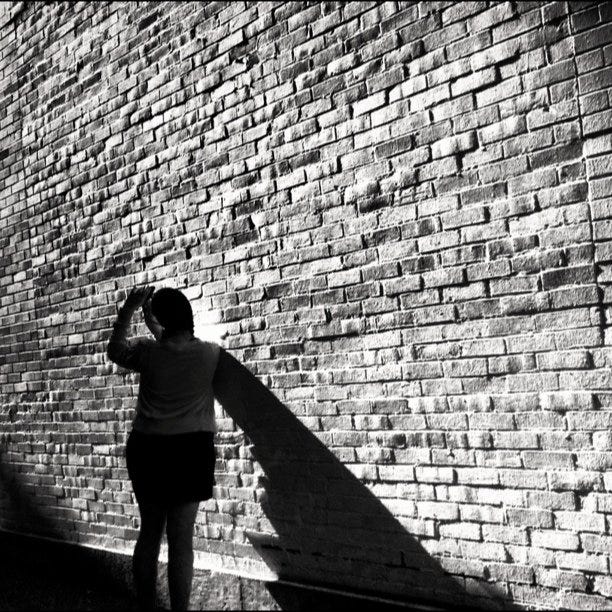Two Ways Light Shapes Presence
When we think of shadows in photography, we often imagine them as accidents—details to be tamed, softened, or erased. But sometimes, it’s the shadows themselves that reveal the truest shape of a story. Two recent images offer a study in contrasts: one an environmental silhouette, the other an intimate portrait fractured by partial light. Both remind us that darkness isn’t the absence of meaning—it’s a space where meaning collects.
The photo above of a person standing against a brick wall relies on precision and scale. The figure is nearly swallowed by the hard diagonal shadow cutting across the frame, a silhouette more gesture than identity. The lighting is unapologetically harsh, with the sun carving a deep, graphic division between brightness and obscurity. From a distance, the subject feels anonymous, like a passerby caught mid-thought. This is solitude rendered in stark geometry: a reminder that even in a crowded city, we can feel utterly alone. The emptiness around the figure becomes the emotional terrain.
Contrast that with the previous photos, a portrait made in partial light—a man in profile, his features just emerging from darkness. Here, the shadow doesn’t obliterate detail; it conceals and reveals in equal measure. The photographer describes stepping back, waiting for the subject to drift into an unguarded moment. When he did, the light found the curve of his cheek, the brim of his cap, and left the rest to mystery. The result is intimate without feeling staged, a study in quiet vulnerability. The background stays simple, but the uneven silhouette behind him creates a tension that softens the directness of his gaze. We’re invited to look closely and still wonder what remains unsaid.
Side by side, these images demonstrate two philosophies of seeing. The alley photo shows how control—of timing, composition, and exposure—can distill a feeling into pure form. It’s a declarative statement: this is isolation, clean and unblinking. The portrait, on the other hand, is an exercise in letting go, allowing imperfection and imbalance to shape the mood. Where the silhouette is about distance, the partial light is about proximity.
It can be tempting to treat these approaches as opposites: one graphic, the other organic; one planned, the other discovered. But in truth, they are two expressions of the same idea—that light is not only what shows, but what hides. And it’s in those hidden spaces—whether they stretch across a brick wall or drift behind a cheekbone—that photography finds its most honest voice.
So the next time you step behind the lens, consider not just what you want to illuminate, but what you’re willing to leave in shadow. Sometimes, that’s where the story waits.
Takeaways
Shadows Aren’t Mistakes—They’re Part of the Story
Both photos show that shadows can reveal emotion and define mood, not just hide information. You don’t always have to fill them in or eliminate them; sometimes, they’re where the story lives.Control vs. Surrender Are Both Valid Approaches
You can plan a shot meticulously, as in the alley silhouette, or let moments unfold organically, like the partial-light portrait. Neither method is better. They create different emotional impacts.Composition Shapes the Viewer’s Relationship to the Subject
Wide framing with ample negative space creates emotional distance and a sense of anonymity. Tight framing with partial light creates a more intimate and vulnerable atmosphere.Light Is Both What You Show and What You Hide
High-contrast lighting clarifies form and can feel dramatic or stark. Soft, bounced, or partial lighting creates nuance and layered emotion.Embrace Imperfection
The article emphasizes that the most authentic images often happen when you loosen your grip on the rules. A little unpredictability in how shadows fall can be what makes a photo memorable.
PhotoCamp Daily is not a newsletter about the technical skills required to be a good photographer or become a photojournalist. There is a multitude of videos, self-help books, training courses, and classes, and then there is the power of social media as an instructional tool.
PhotCamp Daily is about learning to experience making good photos. About learning to better observe subjects and their relationship to story. Learning yourself to express better what will become a collective view of your world and the new experiences you will encounter.
PhotoCamp Daily is always free! But you can pledge support at any time.
Consider subscribing to The Westerville News and My Final Photo News. Also recommended is Into the Morning by Krista Steele.
My Final Photo News is a reader-supported publication. To receive new posts and support photography and commentary, consider becoming a free or paid subscriber.


